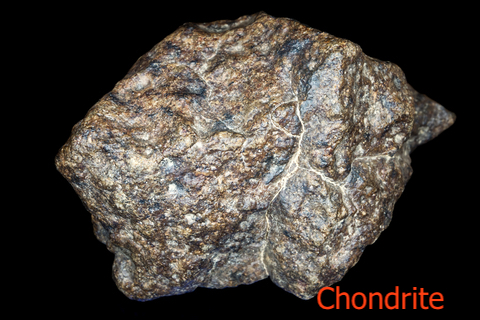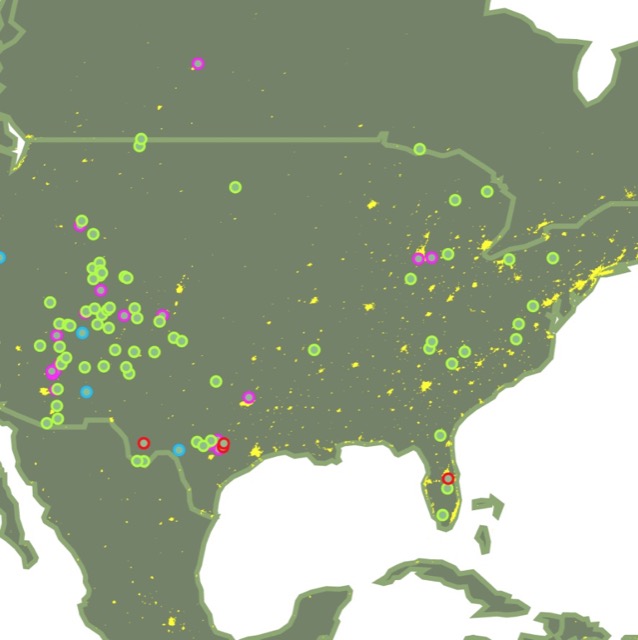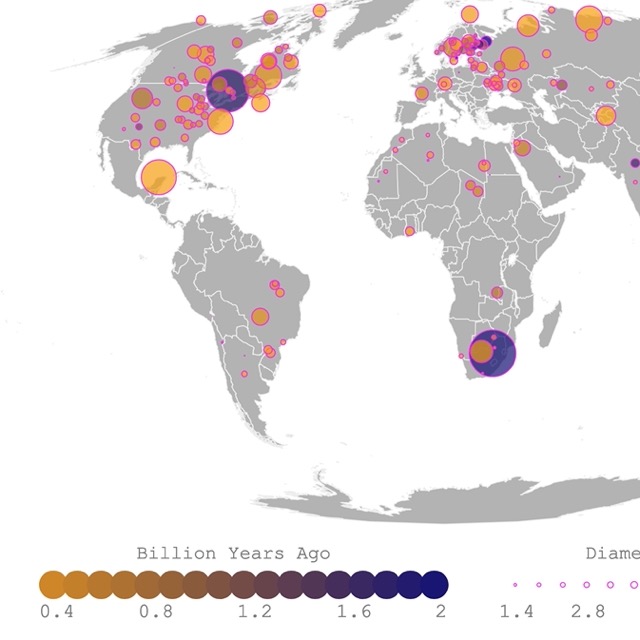Map of Meteorite Landings Worldwide
This interactive map shows the location of Meteorite Landings around the world. The size shows the mass. The color indicates the group, the ring indicates the subgroup. Hover over the map for name, mass, class, and location. For more detail, zoom in the map. For more information, scroll down.
| Meteorites | |||||||||
|---|---|---|---|---|---|---|---|---|---|
| 🔵 | Stony | 🟢 | Stony-Iron | 🔴 | Iron | ||||
| ◯ | Chondrites | ◯ | Achondrites | ◯ | Pallasite | ◯ | Mesosiderite | ||
What is a Meteorite?
Meteorites are rocks that fall on Earth from space. They are pieces of asteroids that are remnants of the solar system's formation.

Asteroids are small rock objects that orbit the sun. Asteroids are smaller than a planet but larger than pebble-sized meteoroids.
Meteoroids are rocks in space; they can be as small as a grain. When meteoroids enter a planet's atmosphere, they burn up. This is because of the high speed, making them look like fireballs. These shooting stars are then called meteors.
Once Meteoroids land on Earth, they are called meteorites.
As it was just explained, the difference between asteroid, meteoroid, meteor, and meteorite is about location and size.
Most meteorites come from the asteroid belt. This is an accumulation of rocks between the orbits of Mars and Jupiter.
Because of meteorites' origin, use they are likely to be older than rocks on Earth, meteorites are helpful to uncover the history of the solar system.
Meteor Showers
It is estimated that 44 tonnes or 44,000 kilograms of meteorites fall on Earth each day.
Most of this material is vaporized when entering the atmosphere. Nevertheless, these meteors are visible at night as shooting stars.
Occasionally, the number of shooting stars increases dramatically. In such instances, it is called a meteor shower.
These events may be regular, as Earth crosses the trail of a comet. A well-known event is the Perseid Meteor shower that peaks every August, NASA.
Comets
Comets orbit the sun like asteroids do. Nevertheless, comets are made of ice and dust, not rock, Space Place.
How Are Meteorites Classified?
There are different ways to classify meteorites. They can be classified according to their texture, mineral composition, chemistry, and presence or absence of chondrules.
Meteorite classification does not imply a similar origin, but it helps scientists communicate and study them. Their classification keeps changing, and new subclasses keep getting added.
Sometimes meteorites do not fit into either category or classification.
The map shows these groups and subgroups in different colors. For the exact type, hover over the map.
Stony or Stone Meteorites
Stony Meteorites are the majority of meteorites found. They are mainly made of silicate minerals.
These meteorites may start looking like regular stones after a while of being on the Earth's surface.
Stony meteorites have a burnt exterior thanks to the heat they experienced when they entered the Earth's atmosphere.
Stony meteorites may have chondrules.

Chondrites
Meteorites that have chondrules are called Chondrites. Chondrules are spherical inclusions. Chondrites are made of these droplets (chondrules) of silicate minerals, mixed with sulfides and iron-nickel metal.
Chondrites can be 4.5 billion years old. This makes them some of the most pristine and oldest rocks in the solar system. Chondrites have never been melted!
Chondrites have enough iron to be attracted by a strong magnet.
Achondrites
Achondrites include meteorites from Mars and the Moon. Chondrites are igneous, so at some point, they melted with magma.

Achondrites are basically volcanic rocks from other celestial bodies.
Achondrites have very little iron, which makes them hard to find.
Lunar (from the Moon) and Martian meteorites are achondrites. These meteorites came to Earth when other meteorites landed on the Moon or Mars and sent the fragments to Earth.
Lunar and Martian meteorites can cost up to $1,000 per gram, Geology.
Stony-Iron Meteorites

Stony-iron meteorites have equal parts of iron-nickel and silicate minerals. Some may even have semi-precious stones.
This is the least abundant meteorite, with less than 2% of all meteorites.
They come in the form of pallasites and mesosiderites.
Pallasites
These meteorites have beautiful crystals embedded in metal.
It is believed these stones are formed at the core-mantle boundary.
Mesosiderites
These rocks are made of broken fragments of cemented rock. They have igneous rocks and metal pieces.
It is believed they were formed in the collision of two asteroids. In this encounter, molten metal mixes with silicate rocks.

Iron Meteorites
These meteorites made of iron, are thought to be the cores of asteroids or former planets. They are some of the densest materials on Earth.
As expected, these iron meteorites will be attracted to magnets. They are usually 90-95% iron; the rest is mainly nickel.
Iron meteorites have a beautiful lattice-like arrangement, only visible when cut, Natural History Museum.
How to Find a Meteorite?
Meteorites fall worldwide, but they are easier to find in places with few rocks and where a dark rock will be easy to spot.
These sites include deserts, ancient dry lakes, and icy regions like Antarctica. All these locations have more circles on the map!
"Stewn fields" are also great locations as these are places where a big meteorite landed and broke into pieces.
Keep in mind that meteorites found in National Parks belong to the Federal Government.
If the meteorite is found on public land, many offices of the Bureau of Land Management will let you keep it!
Is it a Meteorite or a Rock?
If you found a rock and you are not sure it is a Meteorite, make sure it fulfills these conditions suggested by Scientific American:
- It is black or brown.
- It is dense, solid, and has no pores.
- It is metallic
- It is magnetic
Meteorite Landing Facts
- The largest meteorite found is the Hoba meteorite. It is located on the land it was found in Namibia in 1920. It is an Iron meteorite, estimated to weigh 60 tonnes (60,000 kg), Guinness records.
- The largest meteorite found on the United States is the Willamette Meteorite. This Iron meteorite was found in Oregon and it is on display at the American Museum of Natural History in New York City. This meteorite weighs 34,200 pounds (15,500 kg).
- Meteorites detected as they fall are called "falls", those that are discovered later, are referred to as "finds".
- From the 500 estimated meteorites that reach the ground every year, about five are recovered.
- The Chelyabinsk meteor it is the largest known object to have entered Earth's atmosphere since the 1908. This is the only meteor confirmed to have resulted in many injuries in Chelyabinsk Oblast, Russia; The Planets.

Affiliate Disclosure
Databayou.com is a participant in the Amazon Services LLC Associates Program, an affiliate advertising program designed to provide a means for sites to earn advertising fees by advertising and linking to Amazon.com. Databayou.com also participates in affiliate programs with Clickbank, CJ, and other sites.
If you plan to learn, own, or find meteorites, take a look at these items found on Amazon. They can definitely improve your experience.
- In case you want to learn more about meteorites, take a look at Meteorite Mineralogy: This book summarizes the mineralogical characteristics of the myriad varieties of meteorites.
- For a special wedding gift, look into getting the Meteorite Shavings: Engagement Ring, handmade.
- If you want to keep a piece of a meteorite with you, or as a special gift, check this Medallion Pendant: Made of Pallasite Meteorite and Sterling Silver
Resources for Meteorite Landings Map
The data with Meteorite landings and types were downloaded from NASA.
The Shapefiles for countries were downloaded from Natural Earth.
Made by Luz K. Molina with D3.js.










